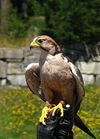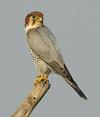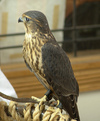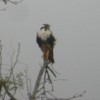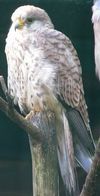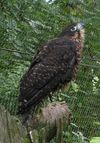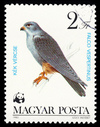Genus Falco
Fox Kestrel - It is a large, slender kestrel with long, narrow wings and tail. It is 32–38 cm long with a wingspan of 76–88 cm and a weight of 250-300 grams. The female is 3% larger than the male. The plumage is dark rufous above and below with black streaks. The tail is narrowly barred with black while the flight feathers of the wing are dark and unbarred. The underwings are pale, contrasting with the darker body. The eye is yellow-brown unlike the similar Greater Kestrel which has whitish eyes as well as paler plumage, barred flight feathers and grey on the tail.
Eastern Red-footed Falcon - The Amur Falcon , formerly Eastern Red-footed Falcon, is a small raptor of the falcon family. It breeds in south-eastern Siberia and Northern China, wintering in Southern Africa.
Seychelles kestrel - The Seychelles Kestrel is a small bird of prey belonging to the genus Falco in the falcon family, Falconidae. It is endemic to the Seychelles Islands where it is the only breeding bird of prey. It is known in Seychellois Creole as the Katiti after its loud, shrill call.
Grey Kestrel - It is a fairly small, stocky kestrel with a large, flat-topped head and fairly short wings that don't reach past the tip of the tail when at rest. It is 28–33 cm long with a wingspan of 58–72 cm and a weight of up to 300 grams. The female is 4-11% larger and 5-11% heavier than the male. The plumage of the adult is uniformly dark grey apart from darker wingtips, faint dark streaking on the body and slightly barred flight feathers. The feet and cere are yellow and there is bare yellow skin around the eye. The most similar species is the Sooty Falcon which has a more rounded head, long wings extending past the tail and less yellow around the eye.
Brown Falcon - The Brown Falcon, Falco berigora, is a member of the falcon genus found in the drier regions of Australia. Its specific name berigora is derived from an aboriginal name for the bird.
Lanner - The Lanner Falcon is a large bird of prey that breeds in Africa, southeast Europe and just into Asia. It is mainly resident, but some birds disperse more widely after the breeding season.
Falco buboisi - Known from subfossil bones and the writings of Dubois published in 1674, this bird was larger than its relative F. punctatus on Mauritius, being about the size of a Common Kestrel, or around 35 cm from head to tail, with males being noticeably smaller than females. This trait, while present in most birds of prey, is most pronounced in the larger, bird-eating species and reduces between-sex competition by niche differentiation. It can be assumed that the bird was of the same generally brownish coloration as its closest relatives, with a lighter underside and darker spots or stipples, the tail, brown or more probably grey, being banded and tipped black. Its feet were yellow and large relative to the bird's overall size. The wingspan was 60-70 cm, its wings being more rounded than those of the Common Kestrel - just as in the Mauritius bird - for increased maneuvrability when hunting in the forest. It is probable, but not certain, that the only difference between the sexes was their size. The bird fed m
Nankeen Kestrel - A very common and easily seen raptor, the Nankeen Kestrel is found in Australia, New Guinea, and nearby islands, and is an irregular visitor to New Zealand. It occupies any type of land that is not too densely vegetated, but in particular temperate grasslands and open woodlands. In the tropical north and the sandy deserts of the west, it has a patchy and seasonal distribution.
Saker - The Saker Falcon is a very large falcon. This species breeds from eastern Europe eastwards across Asia to Manchuria. It is mainly migratory except in the southernmost parts of its range, wintering in Ethiopia, the Arabian peninsula, northern Pakistan and western China. During the end of the last ice age–oxygen isotope stages 3-2, some 40,000 to 10,000 years ago–it also occurred in Poland .
Red-headed Falcon - The Red-necked Falcon or Red-headed Merlin is a bird of prey in the falcon family. This bird is a widespread resident in India and adjacent regions as well as sub-Saharan Africa. It is sometimes called Turumti locally.
Pigeon hawk - The Merlin is a smallish falcon from the Northern Hemisphere. A bird of prey sometimes known colloquially as a pigeon hawk in North America, the Merlin breeds in the northern Holarctic; some migrate to subtropical and northern tropical regions in winter.
Sooty Falcon - This is an elegant bird of prey, 32–37 cm long with a 78–90 cm wingspan. It is shaped like a large Hobby or a small Eleonora's Falcon, with its long pointed wings, long tail and slim body. The adults are blue-grey, and lack the black underwing coverts of the Eleonora’s Falcon. The young bird is like a large juvenile Hobby, or small juvenile Eleanora’s Falcon. Its dark trailing edge to the wings and tail distinguish it from the former species, and it lacks the underwing contrast caused by the dark coverts of the larger falcon.
Orange-breasted Falcon - It is found from southern Mexico to northern Argentina. It's a medium sized bird . It is a bird predator, with strong talons that enable it to catch prey in flight, and is considered by some - as the German-Brazilian ornithologist Helmut Sick - as filling the ecological niche of the Peregrine Falcon as a breeding species in Tropical America. The Orange-breasted Falcon, however, seems to favor more heavily wooded habitats than the Peregrine, therefore the species does not seem to be in ecological competition with Peregrine Falcons wintering in South America.
Dickinson's Kestrel - It is a fairly small, stocky kestrel with a large, square head. It is 27-30 cm long with a wingspan of 61-68 cm and a weight of 167-246 grams. The female is about 4% larger and 10-20% heavier than the male. The plumage is mostly dark grey with a pale head and rump. The tail is grey with narrow black bars and a broad subterminal band. The underside of the flight feathers are also barred. The cere and feet are yellow and there is bare yellow skin around the eye. The bill is dark grey and the eyes are brown. Juvenile birds are grey-brown with barred flanks and without the paler head and rump. They have a greenish cere and eye-ring.
Eleonora's Falcon - This species breeds on islands in the Mediterranean particularly off Greece , but also in the Canary Islands, and off Spain, Italy, Croatia, Morocco and Algeria. Tilos Park is the breeding area for ten percent of the world population of Eleonora Falcons. Six hundred and fifty pairs of this species breed on this island according to research conducted by the Hellenic Ornithological Society and the European Union LIFE-Nature program of Tilos. It is rare as a vagrant north of its range.
Taita Falcon - Its courting and mating period is similar to that of the Peregrine Falcon. The same applies to its vocal as well as territorial preference.
Femoral falcon - The Aplomado Falcon, Falco femoralis, is a medium-sized falcon of the Americas. The species' largest contiguous range is in South America, but not in the deep interior Amazon Basin. It was long known as Falco fusco-coerulescens or Falco fuscocaerulescens, but these names are now believed to refer to the Bat Falcon . Its resemblance in shape to the hobbies accounts for its old name Orange-chested Hobby. Aplomado is an unusual Spanish word for "lead-colored", referring to the blue-grey areas of the plumage – an approximate English translation would be "leaden falcon". Spanish names for the species include halcón aplomado and halcón fajado ; in Brazil it is known as falcão-de-coleira.
Grey Falcon - Mainly grey upperparts and white underparts; darker on the tips of the flight feathers; yellow cere. Body length 30-45 cm; wingspan 85-95 cm; weight 350-600 g. Females larger.
Laggar Falcon - It resembles the Lanner Falcon but is darker overall, and has blackish "trousers" . Fledglings have an almost entirely dark underside, and first-year subadult birds still retain much dark on the belly.
Australian Hobby - It strongly resembles the Peregrine Falcon, however it is much smaller and has darker plumage.
American lanner falcon - The Prairie Falcon is a medium-sized falcon of western North America.
Spotted Kestrel - Spread throughout Australasia, Indomalaya, and most of Wallacea, the Spotted Kestrel inhabits grasslands with scattered trees, lightly wooded cultivation, and the edges of primary and tall secondary forest. Along logging roads, it occasionally penetrates forests, and sometimes inhabits clearings within forested areas. It has also been known to live in areas of human habitation.
Lesser Kestrel - It is a small bird of prey, 27–33 cm in length with a 63–72 cm wingspan. It looks very much like the larger Common Kestrel but has proportionally shorter wings and tail. It shares a brown back and barred grey underparts with the larger species. The male has a grey head and tail like male Common Kestrels, but lacks the dark spotting on the back, the black malar stripe, and has grey patches in the wings.
Madagascar Kestrel - It can reach a size of 30 cm. The wings are 180 mm to 195 mm at the males and 188 mm to 203 mm at the females. The males can reach a weight between 112 and 118 grams. The weight of the females is up to 128 grams. The head and the nape of the males is rufous grey with dark streaks. A dark moustachial streak running from the basis of the bill backwards to sides of the throat. The upperparts and the wingcoverts are chestnut with black spots. The uppertail coverts are grey with blackish spots. The long flight feathers are blackish brown, the inner webs are covered with white and chestnut spots. The underparts are whitish. The short flight feathers are chestnut coloured and dark banded. The chest, belly and underwing coverts are covered with black spots. The tail is grey coloured. It has six to seven narrow black bars and a broad subterminal bar. All feathers have white tips. In addition there is a rufous phase. At this morph the head and nape are almost black. Body and underwing coverts a
New Zealand Falcon - A member of the Falconidae bird family, the Kārearea is mainly found in heavy bush and the steep high country in the South Island and is rarely seen north of a line through the central area of the North Island. A small population also breeds on the Auckland Islands; the species is known only from the Chatham Islands from fossil remains. Although protected since 1970, it is considered to be a vulnerable species.
Saker Falcon - It is a bird of semi-desert and dry open hills. It typically lays its eggs in cliff-ledge nests.
Peregrine Falcon - Falco atriceps Hume Falco kreyenborgi Kleinschmidt, 1929Falco pelegrinoides madens Ripley & Watson, 1963 Rhynchodon peregrinus and see text
Mauritius kestrel - It can reach a size between 26 and 30.5 cm. The weight is up to 250 grams. The males are slightly smaller than the females. The wing is approximately 45 cm and are rounded, unlike those of other falcons.
Bat Falcon - The female Bat Falcon, at 30.5 cm length, is much larger than the 23 cm long male. Adults have a black back, head and tail. The throat, upper breast and neck sides are creamy white, the lower breast and belly are black, finely barred white, and the thighs and lower belly are orange. Young birds are similar but with a buffy throat. The call of this species is a high pitched ke-ke-ke like American Kestrel.
Greater Kestrel - The plumage of the adult is mainly pale rufous, both above and below. The back, upperwing and flanks are barred with black. The breast has dark streaks and the head is streaked but has no malar stripe unlike the Common and Lesser Kestrels. The rump and tail are grey with black bars; the tail has a white tip. In flight, the whitish underwing contrasts with the darker body. The iris of the eye is whitish, distinguishing the bird from any similar species. The bill is mainly blue-grey and the feet and cere are yellow. Juvenile birds have rufous instead of grey on the tail, streaked flanks and a dark eye.
Iceland falcon - The bird's common comes from French gerfaucon, and in medieval Latin is rendered as gyrofalco. The first part of the word may come from Old High German gîr , "vulture", referring to its size compared to other falcons, or the Latin gȳrus from the species' circling as it searches for prey, unlike the other falcons in its range. The male gyrfalcon is called a gyrkin in falconry. The scientific name is composed of the Latin terms for a falcon, Falco, and, for someone who lives in the countryside, rusticolus.
Oriental Hobby - The Oriental Hobby feeds mainly on insects. Its typical habitats are lowland forested areas and woodland. It nests in used nest of other birds either in trees, on building ledges or on cliffs.
American Sparrow Hawk - The American Kestrel is a small falcon. This bird was colloquially known in North America as the "Sparrow Hawk". This name is misleading because it implies a connection with the Eurasian Sparrowhawk Accipiter nisus, which is unrelated; the latter is an accipiter rather than a falcon. Though both are diurnal raptors, they are only distantly related.
Hobby - This species breeds across Europe and Asia. It is a long-distance migrant, wintering in Africa.
Black Falcon - The females are usually around 55 cm from beak to tail, the smaller males being only 45 cm . The sexes are very similar apart from their size. They are comparatively lighter in build than Peregrines with a slightly wider wingspan and longer legs. They are more agile on the ground than Peregrines though less so than Brown Falcons.
Red-footed Falcon - The Red-footed Falcon , formerly Western Red-footed Falcon, is a bird of prey. It belongs to the family Falconidae, the falcons. This bird is found in eastern Europe and Asia although its numbers are dwindling rapidly due to habitat loss and hunting. It is migratory, wintering in Africa. It is a regular wanderer to western Europe, and in August 2004 a Red-footed Falcon was found in North America for the first time on the island of Martha's Vineyard, Massachusetts.
Banded Kestrel - It is 27–30 cm long with a wingspan of 60–68 cm. The upperparts are grey and the tail is dark. The underparts are whitish with dark grey streaks on the throat and upper breast and dark grey barring on the lower breast and belly. The feet, eyes and cere are yellow and there is bare yellow skin around the eye. Juvenile birds are browner than the adults with darker eyes and less bare skin around the eye.



